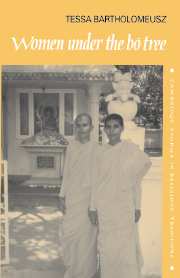Book contents
- Frontmatter
- Contents
- Preface
- Acknowledgments
- Notes on pronunciation
- Dramatis personae
- PART I
- PART II
- 5 The institutionalization of tradition: the early twentieth century and the lay nun
- 6 The lay nun in transitional Ceylon
- 7 The dasa sil mātā in contemporary Sri Lanka
- 8 Novitiates, western lay nuns, and cave dwellers
- 9 The Sri Lankan Bhikkhuī Saňgha: trends and reflections
- Epilogue: Women under the Bō tree
- Appendices
- Notes
- Select bibliographies
- Index and glossary
9 - The Sri Lankan Bhikkhuī Saňgha: trends and reflections
Published online by Cambridge University Press: 05 November 2011
- Frontmatter
- Contents
- Preface
- Acknowledgments
- Notes on pronunciation
- Dramatis personae
- PART I
- PART II
- 5 The institutionalization of tradition: the early twentieth century and the lay nun
- 6 The lay nun in transitional Ceylon
- 7 The dasa sil mātā in contemporary Sri Lanka
- 8 Novitiates, western lay nuns, and cave dwellers
- 9 The Sri Lankan Bhikkhuī Saňgha: trends and reflections
- Epilogue: Women under the Bō tree
- Appendices
- Notes
- Select bibliographies
- Index and glossary
Summary
INTRODUCTION
A few interested parties, laity and lay nuns alike, have taken steps to legitimate the lay nuns' vocation by changing their status from lay to ordained. With the support of the Korean government and interested Sri Lankan Buddhists, several Sri Lankan lay nuns travelled in 1988 to America where five accepted ordination into the monastic order from a dual saňgha; Ayyā Khemā took the vows of the bhiksunī the same time. According to the Vinaya, as we have seen, a dual saňgha is needed to initiate a woman into the order. The monks who participated in the ordination were from Theravāda and Mahāyāna communities in America, while the ordained nuns were drawn from the latter. This ordination of the Sri Lankan lay nuns did not go uncontested; most older monks living in Sri Lanka, who argue that the Buddha never wanted to establish an order of nuns in the first place, echoing the ascetic misogyny of the texts, argue that the lay nuns have not changed status. They have predictably declared that Mahāyāna intervention in Sri Lankan Buddhist affairs destroys the integrity of the Theravādin tradition. They are not alone; the majority of the Sinhala lay nuns I interviewed also regard the Mahāyāna ordination of their peers as illegitimate from the point of view of proper Theravādin practice. Like conservative monks, they claim that Mahāyāna Buddhism is a corrupt version of Theravāda and thus has no place in Sri Lanka.
In addition to those who have received ordination abroad, are other women who claim to be members of the monastic community without having been granted the dual ordination.
- Type
- Chapter
- Information
- Women under the Bo TreeBuddhist nuns in Sri Lanka, pp. 181 - 190Publisher: Cambridge University PressPrint publication year: 1994



